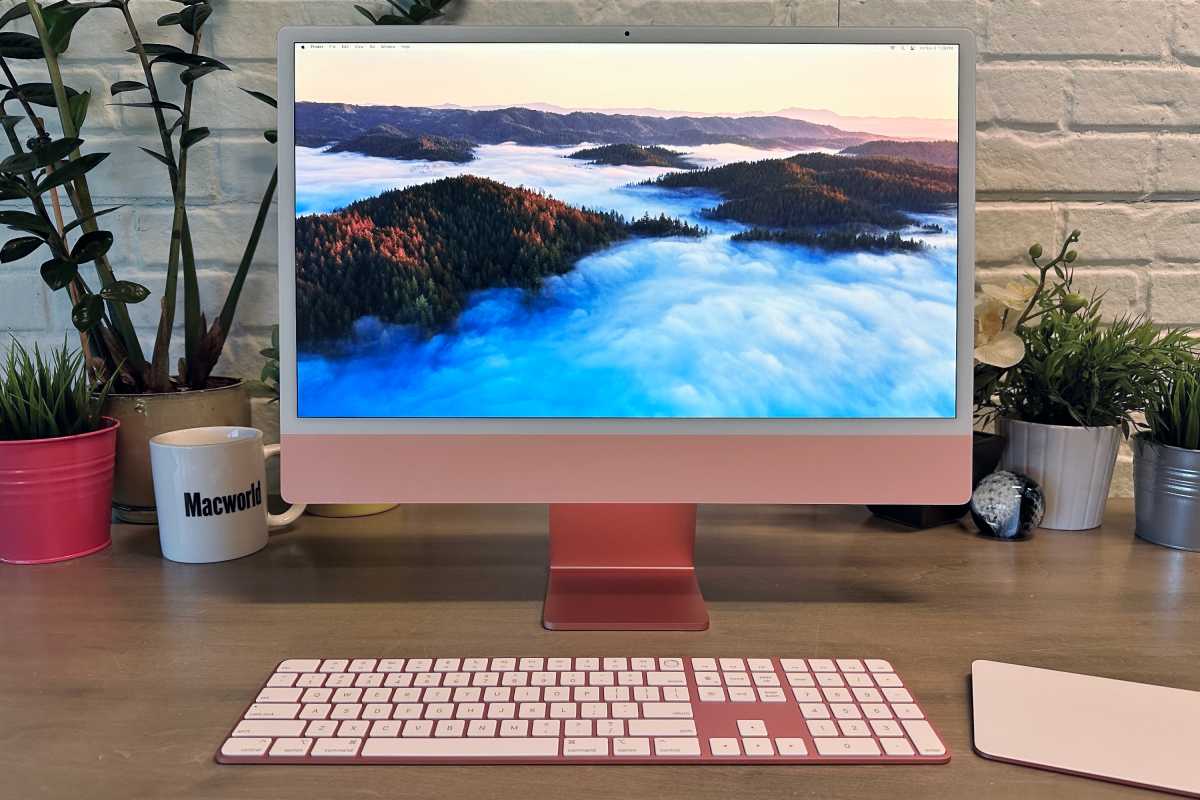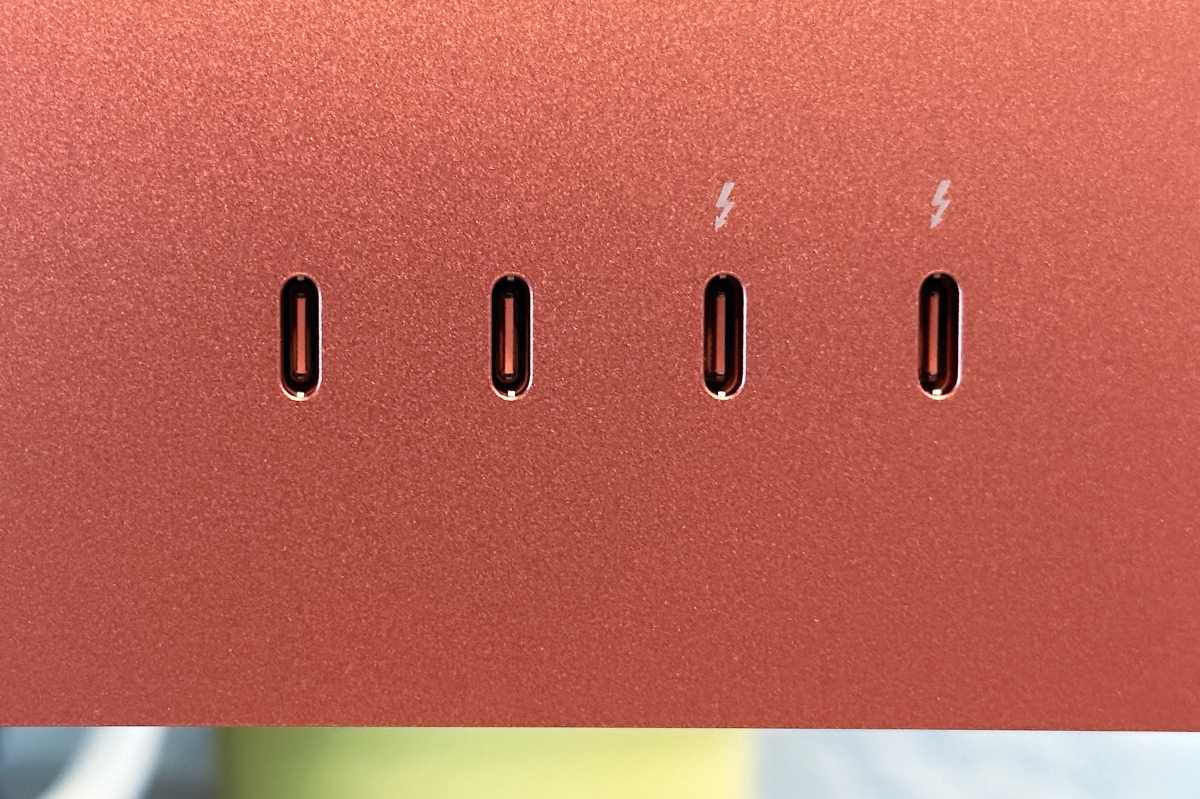Apple has updated its colorful all-in-one desktop with the latest M3 chipsets, bringing the promise of faster performance to the table. But, with most of the components remaining the same as the already powerful M1 iMac, is it really worth spending more to get the latest silicon? We compare the M1 iMac against the M3 iMac to see which one you should buy while the iMac M1 is still available from certain resellers.
You may also be wondering if it’s time to update from an Intel-powered iMac. If you’ve been holding out for Apple to update the iMac it is definitely time to buy one now. Read on to find out just how good the M3 is compared to the old Intel-powered iMacs–it even beats the best iMac Pro!
M3 iMac vs M1 iMac: Specs
There isn’t a lot that is different between the new and old iMac models. Indeed, the biggest differences are between the two-port and four-port models for each generation, with the four-port iMac offering support for a larger SSD and more GPU cores than the two-port model, as well as two USB 3 ports, with USB 3 being the older style USB port, those models also. come with Gigabit Ethernet as standard.
As for inter-generational changes, there are very few. The 2023 M3 iMac can support more memory–up to 24GB Unified Memory, compared to just 16GB. There’s also a 10-core GPU option on the newer chip, which is vastly better than the M1. We have more information about the differences in the sections below.
As a quick outline of the differences between these devices, here are the technical specifications for the baseline models:
| M1 iMac (2 Port) | M1 iMac (4 Port) | M3 iMac (2 Port) | M3 iMac (4 Port) | |
| Dimensions | 18.1 x 21.5 x 5.8in / 46.1 x 54.7 x 14.7cm | 18.1 x 21.5 x 5.8in / 46.1 x 54.7 x 14.7cm | 18.1 x 21.5 x 5.8in / 46.1 x 54.7 x 14.7cm | 18.1 x 21.5 x 5.8in / 46.1 x 54.7 x 14.7cm |
| Weight | 9.83lbs / 4.46kg | 9.88lbs / 4.48kg | 9.75lbs / 4.43kg | 9.87lbs / 4.48kg |
| Processor | M1 | M1 | M3 | M3 |
| CPU | 8-core CPU with 4 performance cores and 4 efficiency cores | 8-core CPU with 4 performance cores and 4 efficiency cores | 8-core CPU with 4 performance cores and 4 efficiency cores | 8-core CPU with 4 performance cores and 4 efficiency cores |
| GPU | 7-core | 8-core | 8-core | 10-core |
| Neural Engine | 16-core | 16-core | 16-core | 16-core |
| RAM | 8GB/16GB | 8GB/16GB | 8GB/16GB/24GB | 8GB/16GB/24GB |
| Storage | 256GB/512GB/1TB SSD | 256GB/512GB/1TB/2TB SSD | 256GB/512GB/1TB SSD | 256GB/512GB/1TB/2TB SSD |
| Display | 24-inch 4.5K Retina Display, 4480 x 2520, 500 nits brightness, Wide Color (P3), True Tone | 24-inch 4.5K Retina Display, 4480 x 2520, 500 nits brightness, Wide Color (P3), True Tone | 24-inch 4.5K Retina Display, 4480 x 2520, 500 nits brightness, Wide Color (P3), True Tone | 24-inch 4.5K Retina Display, 4480 x 2520, 500 nits brightness, Wide Color (P3), True Tone |
| Audio | Six-speaker system with force-cancelling woofers, support for Spatial Audio and Dolby Atmos | Six-speaker system with force-cancelling woofers, support for Spatial Audio and Dolby Atmos | Six-speaker system with force-cancelling woofers, support for Spatial Audio and Dolby Atmos | Six-speaker system with force-cancelling woofers, support for Spatial Audio and Dolby Atmos |
| FaceTime Camera | 1080p | 1080p | 1080p | 1080p |
| Wi-Fi | Wi-Fi 6 (802.11ax) | Wi-Fi 6 (802.11ax) | Wi‑Fi 6E (802.11ax) | Wi‑Fi 6E (802.11ax) |
| Bluetooth | 5 | 5 | 5.3 | 5.3 |
| Ports | 2 x Thunderbolt / USB 4, 3.5mm headphone jack | 2 x Thunderbolt / USB 4, 2x USB 3, Ethernet, 3.5mm headphone jack | 2 x Thunderbolt / USB 4, 3.5mm headphone jack | 2 x Thunderbolt / USB 4, 2x USB 3, Ethernet, 3.5mm headphone jack |
M3 iMac vs M1 iMac: Price
You’ll notice from the pricing below that the iMac price didn’t change when the M3 iMac was introduced. Apple had previously put up prices in the U.K. and other parts of the world outside the U.S. and the company didn’t take the opportunity to readjust prices (although it did with the similarly timed MacBook Pro update).
In terms of what you get for your money, the iMac has a high price in comparison to other Macs. For example, the Mac mini and Mac Studio are far cheaper but lack a screen. Even the MacBook Pro with the same 8-core CPU/10-core GPU M3 chip and 512GB SSD costs $1,599/£1,699, while that same configuration would cost $1,699/£1,799 for the iMac.
As is standard practice for Apple, the introduction of the M3 iMac means that its predecessor is now discontinued. However, you may still be able to pick up an M1 iMac from retailers, who are likely to discount the older model. Alternatively, head to the Apple Refurbished store where you could save some money on the M1 model. Read: Why you should buy a refurbished Mac.
Before you buy check how much Apple sells, or sold the iMac for. Here’s how the various configurations were priced:
M3 iMac:
- 8-core CPU, 8-core GPU, 2-port, 256GB – $1,299/£1,399
- 8-core CPU, 10-core GPU, 4-port, 256GB – $1,499/£1,599
- 8-core CPU, 10-core GPU, 4-port, 512GB – $1,699/£1,799
M1 iMac:
- 8-core CPU, 7-core GPU, 2-port, 256GB – $1,299/£1,399 (was £1,249 at launch)
- 8-core CPU, 8-core GPU, 4-port, 256GB – $1,499/£1,599 (was £1,449 at launch)
- 8-core CPU, 8-core GPU, 4-port, 512GB – $1,699/£1,799 (was £1,649 at launch)
It is likely that resellers will offer discounts on the new and old iMac models. Check the boxes below for the best prices on the entry-level models right now, you’ll find all the iMac models in our round-up of the best iMac deals.
iMac, M3, 8-core CPU, 8-core GPU, 256GB SSD, 8GB memory, MSRP $1,299/£1,399
8-core CPU, 7-core GPU, 256GB, MSRP $1,299/£1,399 (was £1,249)
M3 iMac vs M1 iMac: Design
The M3 iMac is essentially the same in terms of aesthetics and construction. When Apple launched the M1 iMac in 2021, it did so with a brand new design that brought color back to the platform. Old Intel-powered iMacs are silver, while the iMac Pro came in a darker Space Grey shade of aluminium. The M3 iMac generation haven’t changed at all in terms of design. You still have the following color choices: Blue, green, pink and silver on the entry-level model, and additionally yellow, orange and purple for the 4-port models.
The color-schemes have bolder hues on the back of the iMac, while the front are softer, pastel versions. These are accompanied by white bezels that frame the 24-inch display.

iMac color scheme.
Apple
In traditional iMac fashion, the ports are all situated at the rear of the display, leaving the classic iMac chin on the front for you to place stickers or Post-It notes on. You still can’t change the height of the display, which is a long-running issue with iMacs, so you might be sitting the iMac on a pile of hard-backed books if you need to position the display a little higher.
All of the models share the same dimensions of 18.1 x 21.5 x 5.8in / 46.1 x 54.7 x 14.7cm with only slight variances when it comes to weight, although this means next to nothing as once an iMac is set up on your desk, it’s unlikely you’ll be moving it much.

Foundry
Apple includes its wireless Magic Keyboard and Magic Mouse (you can get a Magic Trackpad instead of mouse for an extra $50/£50), although if you want Touch ID on these you’ll need to opt for the 4-port versions, as the 2-port ones come with a lock key instead. You can, of course, upgrade to the Touch ID one if you pay extra.
M3 iMac vs M1 iMac: Performance
The main difference between the M1 and M3 model are of course the chipsets inside. When Apple moved from Intel processors to its own M-series of silicon, this came with a huge jump in performance. Since then, the M-series has grown steadily in its speed, with Apple claiming that the M3 chipset is up to 2x faster than the M1.
It should be noted that those tests were between an M3 iMac with 24GB of RAM while the M1 iMac was equipped with only 16GB (both the maxed-out configurations), so it’s uncertain how the baseline models with similar configurations would fare. But, you can be sure, neither will be a slouch.
To see the raw power of the M-series processors when put head to head, here’s our benchmark test results below. As you can see, the M3 speeds are definitely faster than the M1 chips, in fact the M3 beats the M1 Pro in some cases.
In fact, if you compare the M3 iMac to the iMac Pro with Intel Xeon W-2191B 2.3GHz, as we have in the table below, you can see that the M3 iMac is better than the best iMac Pro.
If you’re only intending to use the iMac for surfing the web, video calls, streaming entertainment or working with documents and spreadsheets, then you won’t really notice much difference between the M1 and M3 though.
But, should you want to load up Logic and record music, do some video editing or a spot of gaming, then the M3’s higher performance abilities will definitely come into play. Especially as it supports ProRes, ProRes RAW, has a ProRes encode and decode engine and AV1 decode. Plenty for photographers and videographers to play with.
M3 iMac vs M1 iMac: Display
The display is the same on the M3 iMac as it was on the M1 version. This means you get a 24-inch Retina Display running at a 4,480 x 2,520 (4.5K) resolution, with Wide Color (P3) and True Tone technology.
Brightness goes up to 500 nits, which means you won’t struggle to see the screen even in strongly lit areas. The panels can be quite reflective though, so you might need to place it in a location that isn’t directly facing a window.

Apple
In our review of the M1 iMac, Senior Editor Roman Loyala said ‘It’s a gorgeous display, with good brightness, great detail, and excellent color.’ As the M3 panel is the same, we think you’ll be very satisfied with either device.
M3 iMac vs M1 iMac: Audio and webcam
Again, there’s nothing much to separate the generations of iMacs when it comes to audio. All models feature a six-speaker system with force-cancelling woofers, and support for Spatial Audio and Dolby Atmos. This means you’ll get solid audio performance when listening to music or streaming Netflix.
If you prefer to keep things quiet for everyone else, then the 3.5mm headphone jack will allow you to plug in your favorite set of cans. One bonus for the M3 iMacs is that this feature also supports high-impedance headphones such as those you’d use for audio engineering.
A three mic array captures sound, so you’ll sound crisp and articulate when on video calls.
There’s no change with the webcam either: Apple bestows its 1080p FaceTime HD camera on both the M1 and M3 iMacs (a vast improvement on the camera in the Intel-powered iMac). This FaceTime HD camera doesn’t have Center Stage (Apple’s feature that follows you if you move out of frame), as this requires the TrueDepth camera, which also means you can’t use Face ID on the iMacs either. For video calls it’s a decent enough webcam.
M3 iMac vs M1 iMac: Ports and connectivity
As you have probably surmised from the listing above, Apple offers each generation of iMac in two variants – 2-port and 4-port. Those extra ones are in the form of two USB 3 ports (that’s the old-style USB), rather than additional Thunderbolt 4/USB-C connections. Of course, you can always add a USB-C hub if you need to expand your storage after buying the iMac.

Foundry
In terms of connectivity, you’ll find Wi-Fi 6 and Bluetooth 5.0 on the M1 iMac, while the M3 models upgrade this to Wi-Fi6e and Bluetooth 5.3. The 4-port models also include a Gigabit Ethernet port, while it’s only a configuration option on the 2-port machines.
M3 iMac vs M1 iMac: Verdict
So many aspects of the two iMac generations are the same. They share identical displays, speakers, webcams, construction and color schemes. The only real differences are the chipset and minor upgrades to the Wi-Fi and Bluetooth connections. That being said, if you want to use the iMac for video and photo editing, then the M3 chipset definitely makes a difference. If you want a bargain, we’d suggest looking around to see if you can pick up the M1 iMac on a deal. You’re getting around 90% of the same machine, but may save more than 10% of the cost. If you are thinking of replacing an older Intel-powered iMac, the time is ripe to do so.





